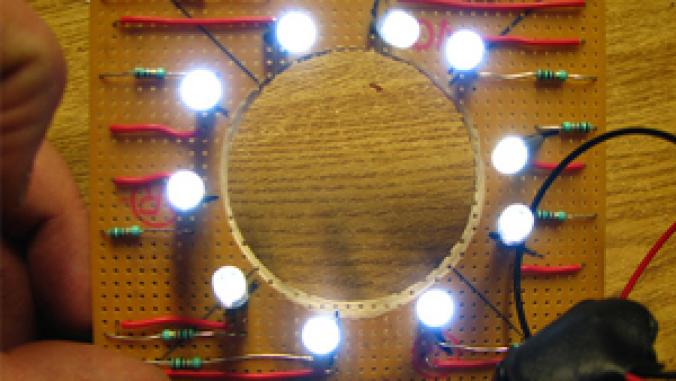Bringing Jobs, Products Back to Life
St. Vincent de Paul of Lane County, Ore., creates marketable products and jobs from wood, glass, and other discards removed from the waste stream. From In Business magazine.
St. Vincent de Paul of Lane County, Ore., creates marketable products and jobs from wood, glass, and other discards removed from the waste stream. From In Business magazine.
The Lane County, Ore., affiliate of St. Vincent de Paul (SVDP), an international Catholic charity, thrives as an entrepreneurial nonprofit. It capitalizes on niche market opportunities, converting more than 40 tons of discarded products a day into marketable furniture, glassware, mattresses, building materials, and appliances.
“We’ve discovered that waste stream diversion is a good niche for this organization, a good way to create the income we need,” says Terry McDonald, who runs the operation. “We add value to products and bring them back to life.”
At the Aurora Glass Foundry, a division of SVDP, a local recycler delivers windowpane glass, soda bottles and jars, from which seven full-time employees create hot-selling items such as sun catchers and commemorative pieces. They crush the glass, melt it down, and add color. When shaped and cooled, the “reborn” items are sold at St. Vincent’s gift shop as well as wholesale. The home decor product line features table lamps, coasters, and bowls.
Wood Shop Wonder
In 1989, SVDP wanted to add dressers and bookcases to its thrift stores, but the few available units were badly damaged, and not fit for resale. The solution? Development of a wholly sustainable wood shop to produce low-end durable dressers that would also build a job-training program and jobs and reclaim recycled and postmanufacturing waste.
It worked. Staff designed a chipboard four-drawer dresser that retailed for $20, reclaiming chipboard “blows” or imperfect boards that normally would go to the dump. Although durable, the material was suitable only for garage or storage use. Manufacturing this dresser allowed the woodshop to learn the process and identify markets while perfecting new products. Skills learned in building chipboard dressers helped staff move up to pine/melamine dressers and nightstands made from virgin western pine.
“We are able to access an appropriate product at reduced cost that often is landfilled,” McDonald said. “The drawer back, bottom and sides are made from postmanufacturing waste hardboard material which we divert from a local manufacturer.”
According to McDonald, the interesting thing about the wood shop is that staff continue to find new ways to add recycled materials into the mix. “For example, when one of our housing projects needed expensive triple bead molding, we made it out of recycled water bed frames,” McDonald said. Rail materials in another project were made out of a special run of ashwood that would normally be used as firewood. Odd lots of exotic woods from local manufacturers have been remilled to make bases for glass awards from Aurora Glass.
“With a little creativity and thought, postmanufacturing waste and recycled materials are now finding their way into all our wood products and housing production,” McDonald said.
Recycled Mattress Factory/Mattress Shredder
In 1990, when too few reusable used mattresses came into the thrift operation, staff recommended setting up a mattress factory for rebuilding box springs and mattresses. In the years to come, staff would divert thousands of mattresses from the landfill. At local transfer sites, trailers have been set up to drop off discarded mattresses; filled trailers are hauled to the SVDP factory, where employees sort the rebuildable and reusable products. New fabric, ticking, foam and cotton are put on the frame, and all rebuilt mattresses are given a one-year warranty. McDonald said he estimates that 80% of twin, full and queen mattresses have been diverted from the dump.
St. Vincent is designing a system to shred all residual mattress products that cannot be reused or rebuilt. An SVDP affiliate in Oakland, Calif., is implementing a deconstruction system to divert mattresses collected in Alameda and San Francisco counties. For the Bay Area, this amounts to more than 300 units a day. Poly foam and toppers will be directed to the carpet pad industry, steel back to the steel industry, and wood to hog fuel users. St. Vincent is working with the International Sleep Products Association, the Alameda and San Francisco solid waste departments, and others to expand the program.
Appliance Recycling and Green Building
Twenty years ago, St. Vincent was rebuilding an average of 25 appliances per month in Eugene, Ore. In 2000, McDonald estimated the number at more than 300. Appliances that are not rebuildable have their motors removed, oil drained, and CFCs recycled. “St. Vincent operations recycle over 16 tons of appliances per day,” McDonald said. “Our next venture is likely to be in computer recycling. Our solid waste district is absorbing over 25 tons of computer junk per month.”
These Programs Hit Home
St. Vincent also looks at where people live. As part of its emphasis on community outreach programs, SVDP has built or restored more than 300 units of affordable housing, with 250 more under development. Increasingly, this focus is incorporating green building activities for permanent affordable rentals, duplexes, single residence occupancy units, apartments, and transitional housing for homeless families.
According to Amanda Saul of the SVDP staff, the housing program is taking steps to further its innovative approach to housing development to ensure new buildings have less environmental impact and are healthier to live in.
“This means that whenever possible, future housing built by SVDP will use green building materials and techniques such as wheatboard, tankless water heaters, solar heaters and biofiltration swales,” Saul said. “This strategy will affect all stages of the development process from planning and design to construction and even deconstruction of buildings.”
Saul said SVDP has compiled a resource book to help members of the development team (from architects to contractors to property managers) identify and locate green products, and weigh the costs and benefits.
For more information, contact St. Vincent de Paul of Lane County, Inc., P.O. Box 24608, Eugene, Ore., 97402, 541-687-5820.
----------------
This piece first ran in In Business magazine, November/December 2000. Copyright In Business 2001, all rights reserved. In Business is a GreenBiz News Affiliate.
The Lane County, Ore., affiliate of St. Vincent de Paul (SVDP), an international Catholic charity, thrives as an entrepreneurial nonprofit. It capitalizes on niche market opportunities, converting more than 40 tons of discarded products a day into marketable furniture, glassware, mattresses, building materials, and appliances.
“We’ve discovered that waste stream diversion is a good niche for this organization, a good way to create the income we need,” says Terry McDonald, who runs the operation. “We add value to products and bring them back to life.”
At the Aurora Glass Foundry, a division of SVDP, a local recycler delivers windowpane glass, soda bottles and jars, from which seven full-time employees create hot-selling items such as sun catchers and commemorative pieces. They crush the glass, melt it down, and add color. When shaped and cooled, the “reborn” items are sold at St. Vincent’s gift shop as well as wholesale. The home decor product line features table lamps, coasters, and bowls.
Wood Shop Wonder
In 1989, SVDP wanted to add dressers and bookcases to its thrift stores, but the few available units were badly damaged, and not fit for resale. The solution? Development of a wholly sustainable wood shop to produce low-end durable dressers that would also build a job-training program and jobs and reclaim recycled and postmanufacturing waste.
It worked. Staff designed a chipboard four-drawer dresser that retailed for $20, reclaiming chipboard “blows” or imperfect boards that normally would go to the dump. Although durable, the material was suitable only for garage or storage use. Manufacturing this dresser allowed the woodshop to learn the process and identify markets while perfecting new products. Skills learned in building chipboard dressers helped staff move up to pine/melamine dressers and nightstands made from virgin western pine.
“We are able to access an appropriate product at reduced cost that often is landfilled,” McDonald said. “The drawer back, bottom and sides are made from postmanufacturing waste hardboard material which we divert from a local manufacturer.”
According to McDonald, the interesting thing about the wood shop is that staff continue to find new ways to add recycled materials into the mix. “For example, when one of our housing projects needed expensive triple bead molding, we made it out of recycled water bed frames,” McDonald said. Rail materials in another project were made out of a special run of ashwood that would normally be used as firewood. Odd lots of exotic woods from local manufacturers have been remilled to make bases for glass awards from Aurora Glass.
“With a little creativity and thought, postmanufacturing waste and recycled materials are now finding their way into all our wood products and housing production,” McDonald said.
Recycled Mattress Factory/Mattress Shredder
In 1990, when too few reusable used mattresses came into the thrift operation, staff recommended setting up a mattress factory for rebuilding box springs and mattresses. In the years to come, staff would divert thousands of mattresses from the landfill. At local transfer sites, trailers have been set up to drop off discarded mattresses; filled trailers are hauled to the SVDP factory, where employees sort the rebuildable and reusable products. New fabric, ticking, foam and cotton are put on the frame, and all rebuilt mattresses are given a one-year warranty. McDonald said he estimates that 80% of twin, full and queen mattresses have been diverted from the dump.
St. Vincent is designing a system to shred all residual mattress products that cannot be reused or rebuilt. An SVDP affiliate in Oakland, Calif., is implementing a deconstruction system to divert mattresses collected in Alameda and San Francisco counties. For the Bay Area, this amounts to more than 300 units a day. Poly foam and toppers will be directed to the carpet pad industry, steel back to the steel industry, and wood to hog fuel users. St. Vincent is working with the International Sleep Products Association, the Alameda and San Francisco solid waste departments, and others to expand the program.
Appliance Recycling and Green Building
Twenty years ago, St. Vincent was rebuilding an average of 25 appliances per month in Eugene, Ore. In 2000, McDonald estimated the number at more than 300. Appliances that are not rebuildable have their motors removed, oil drained, and CFCs recycled. “St. Vincent operations recycle over 16 tons of appliances per day,” McDonald said. “Our next venture is likely to be in computer recycling. Our solid waste district is absorbing over 25 tons of computer junk per month.”
These Programs Hit Home
St. Vincent also looks at where people live. As part of its emphasis on community outreach programs, SVDP has built or restored more than 300 units of affordable housing, with 250 more under development. Increasingly, this focus is incorporating green building activities for permanent affordable rentals, duplexes, single residence occupancy units, apartments, and transitional housing for homeless families.
According to Amanda Saul of the SVDP staff, the housing program is taking steps to further its innovative approach to housing development to ensure new buildings have less environmental impact and are healthier to live in.
“This means that whenever possible, future housing built by SVDP will use green building materials and techniques such as wheatboard, tankless water heaters, solar heaters and biofiltration swales,” Saul said. “This strategy will affect all stages of the development process from planning and design to construction and even deconstruction of buildings.”
Saul said SVDP has compiled a resource book to help members of the development team (from architects to contractors to property managers) identify and locate green products, and weigh the costs and benefits.
For more information, contact St. Vincent de Paul of Lane County, Inc., P.O. Box 24608, Eugene, Ore., 97402, 541-687-5820.
----------------
This piece first ran in In Business magazine, November/December 2000. Copyright In Business 2001, all rights reserved. In Business is a GreenBiz News Affiliate.




